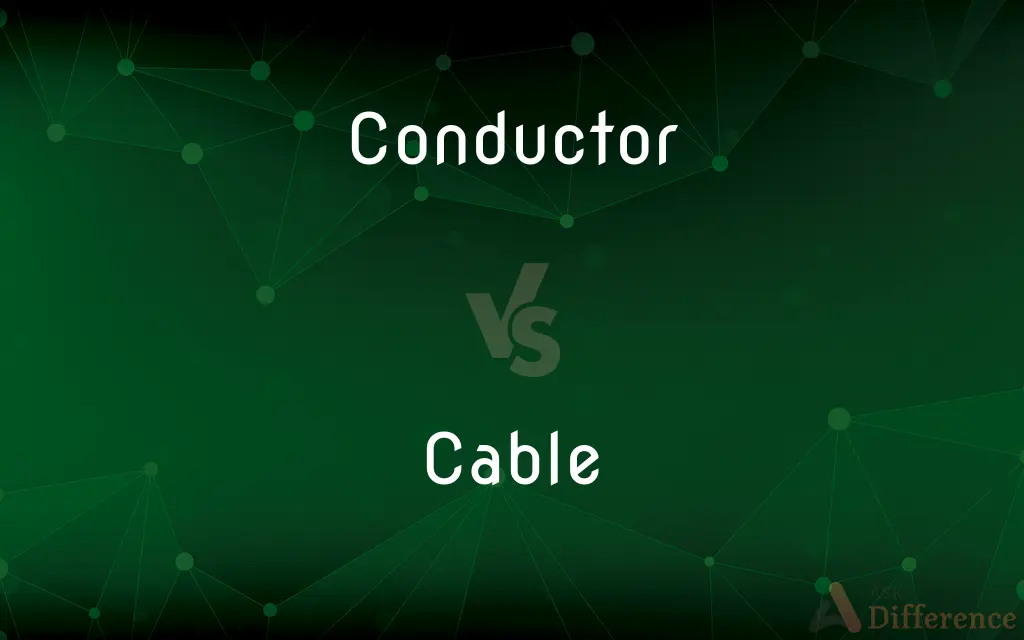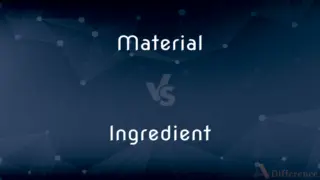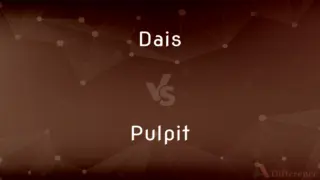Conductor vs. Cable — What's the Difference?
By Tayyaba Rehman & Urooj Arif — Updated on April 2, 2024
A conductor is a material that allows electrical current to flow with minimal resistance, e.g., copper wire, while a cable is a collection of one or more conductors insulated and possibly shielded, used for transmission of electrical power or signals.

Difference Between Conductor and Cable
Table of Contents
ADVERTISEMENT
Key Differences
Conductors are materials or objects that facilitate the flow of electric current with minimal resistance due to their free-moving electrons. Common conductors include metals like copper and aluminum, known for their excellent conductivity. On the other hand, a cable is an assembly of one or more conductors, often encased in an insulation layer and sometimes a protective outer layer. Cables are designed to transmit electricity or signals from one point to another, providing not just a pathway for current but also protection against external factors like moisture, physical damage, and electromagnetic interference.
While conductors are evaluated mainly on their ability to conduct electricity efficiently, which is determined by their material composition, cables are also assessed based on their insulation and shielding properties. Insulation prevents leakage of current and protects the conductors within, whereas shielding protects against external electromagnetic interference. This makes cables suitable for a wide range of applications, from simple electrical connections in household appliances to complex data and signal transmission in telecommunications.
In terms of application, conductors are the fundamental components used in the manufacturing of cables and other electrical components. They are the critical elements that allow the flow of electrical current. Cables, however, are more about the application and functionality, tailored for specific uses like power transmission, telecommunications, and networking, encompassing various types of conductors based on the requirement.
Another point of distinction lies in the construction. A single conductor may suffice for simple circuit connections, but cables, comprising multiple conductors, can carry multiple signals or power streams simultaneously. This complexity allows for more sophisticated communication and power systems, where multiple channels of information or power distribution are required.
The environmental and physical protection offered by cables is a significant difference. While conductors are often vulnerable to oxidation and physical damage, the insulation and protective sheaths of cables provide resistance against harsh environmental conditions and mechanical stress, ensuring longevity and reliability of the electrical and signal transmissions.
ADVERTISEMENT
Comparison Chart
Composition
Single material, often metal
Multiple conductors, insulation, sheath
Function
Facilitate flow of electric current
Transmit electricity/signals, protection
Properties Evaluated
Conductivity, resistance
Insulation, shielding, flexibility
Application
Basic electrical components, wiring
Power systems, telecommunications, data
Protection
Minimal, prone to damage
Enhanced, against environmental/EMI damage
Compare with Definitions
Conductor
A material through which electrons can move freely.
Aluminum, being a good conductor, is widely used in power lines.
Cable
An assembly of one or more conductors with insulation.
The Ethernet cable in your home transmits data at high speeds.
Conductor
A component integral to electrical circuits for conducting current.
A gold conductor offers superior performance for high-quality electronics.
Cable
Enclosed conductors that can be buried or strung overhead.
Underground cables are protected from environmental conditions.
Conductor
The medium through which electrical energy flows.
Water can act as a conductor when it contains salts.
Cable
A protective and insulated wire or wires for transmitting electricity or signals.
The coaxial cable is commonly used for cable television.
Conductor
A substance that allows the flow of electric current with minimal resistance.
Copper is a popular conductor due to its high conductivity.
Cable
A flexible and insulated electric wire.
The USB cable connects your phone to a computer for charging and data transfer.
Conductor
Any material that can transmit electricity.
Silver is the best conductor but is too expensive for common use.
Cable
A bundle of wires or fibers for communication or power transfer.
Fiber optic cables transmit data using light.
Conductor
One who is in charge of a railroad train, bus, or streetcar.
Cable
A strong, large-diameter, heavy steel or fiber rope.
Conductor
(Music) One who directs an orchestra or other such group.
Cable
Something that resembles such steel or fiber rope.
Conductor
(Physics) A substance or medium that conducts heat, light, sound, or especially an electric charge.
Cable
(Electricity) A bound or sheathed group of mutually insulated conductors.
Conductor
A lightning rod, as on a house or barn.
Cable
A sheathed bundle of optical fibers.
Conductor
One who conducts or leads; a guide; a director.
Cable
A heavy rope or chain for mooring or anchoring a ship.
Conductor
(music) A person who conducts an orchestra, choir or other music ensemble; a professional whose occupation is conducting.
Cable
A cable length.
Conductor
(rail transport) A person who takes tickets on public transportation and also helps passengers.
Train conductor
Tram conductor
Cable
Cable television.
Conductor
(physics) Something that can transmit electricity, heat, light, or sound.
Cable
A similar service providing internet access.
Conductor
(mathematics) An ideal of a ring that measures how far it is from being integrally closed
Cable
A cablegram.
Conductor
A grooved sound or staff used for directing instruments, such as lithontriptic forceps; a director.
Cable
Of or relating to a subscription television or internet service that uses cables to carry signals between local distribution antennas and the subscriber's location.
Conductor
(architecture) A leader.
Cable
To send a cablegram to.
Conductor
One who, or that which, conducts; a leader; a commander; a guide; a manager; a director.
Zeal, the blind conductor of the will.
Cable
To transmit (a message) by telegraph.
Conductor
One in charge of a public conveyance, as of a railroad train or a street car.
Cable
To supply or fasten with a cable or cables.
Conductor
The leader or director of an orchestra or chorus.
Cable
To send a cablegram.
Conductor
A substance or body capable of being a medium for the transmission of certain forces, esp. heat or electricity; specifically, a lightning rod.
Cable
(material) A long object used to make a physical connection.
Conductor
A grooved sound or staff used for directing instruments, as lithontriptic forceps, etc.; a director.
Cable
A strong, large-diameter wire or rope, or something resembling such a rope.
Conductor
Same as Leader.
Cable
An assembly of two or more cable-laid ropes.
Conductor
The person who leads a musical group
Cable
An assembly of two or more wires, used for electrical power or data circuits; one or more and/or the whole may be insulated.
Conductor
A device designed to transmit electricity, heat, etc.
Cable
(nautical) A strong rope or chain used to moor or anchor a ship.
Conductor
A substance that readily conducts e.g. electricity and heat
Cable
(communications) A system for transmitting television or Internet services over a network of coaxial or fibreoptic cables.
I tried to watch the movie last night but my cable was out.
Conductor
The person who collects fares on a public conveyance
Cable
(TV) cable television, broadcast over the above network, not by antenna.
Cable
A telegram, notably when sent by (submarine) telegraph cable.
Cable
(nautical) A unit of length equal to one tenth of a nautical mile.
Cable
100 fathoms, 600 imperial feet, approximately 185 m.
Cable
(finance) The currency pair British Pound against United States Dollar.
Cable
(architecture) A moulding, shaft of a column, or any other member of convex, rounded section, made to resemble the spiral twist of a rope.
Cable
(knitting) A textural pattern achieved by passing groups of stitches over one another.
Cable
(transitive) To provide with cable(s)
Cable
(transitive) To fasten (as if) with cable(s)
Cable
(transitive) To wrap wires to form a cable
Cable
(transitive) To send a telegram, news, etc., by cable
Cable
(intransitive) To communicate by cable
Cable
To ornament with cabling.
Cable
(knitting) To create cable stitches.
Cable
A large, strong rope or chain, of considerable length, used to retain a vessel at anchor, and for other purposes. It is made of hemp, of steel wire, or of iron links.
Cable
A rope of steel wire, or copper wire, usually covered with some protecting or insulating substance; as, the cable of a suspension bridge; a telegraphic cable.
Cable
A molding, shaft of a column, or any other member of convex, rounded section, made to resemble the spiral twist of a rope; - called also cable molding.
Cable
To fasten with a cable.
Cable
To ornament with cabling. See Cabling.
Cable
To telegraph by a submarine cable
Cable
A telegram sent abroad
Cable
A conductor for transmitting electrical or optical signals or electric power
Cable
A very strong thick rope made of twisted hemp or steel wire
Cable
A nautical unit of depth
Cable
Television that is transmitted over cable directly to the receiver
Cable
A television system transmitted over cables
Cable
Send cables, wires, or telegrams
Cable
Fasten with a cable;
Cable trees
Common Curiosities
Can cables transmit data?
Yes, cables can transmit data and are essential for telecommunications, internet, and many digital communications.
Is copper the only material used in conductors?
While copper is a common material due to its high conductivity and flexibility, aluminum and silver are also used as conductors.
How do environmental factors affect cables?
Environmental factors like temperature, humidity, and physical stress can affect cable performance, which is why cables are designed with protective sheathing.
Can a conductor be used as a cable?
No, a conductor cannot function as a cable on its own due to lack of insulation and protection.
Why are cables insulated?
Cables are insulated to prevent electric shocks, protect the conductors from damage, and ensure safe transmission of power or signals.
Are all metals good conductors?
Most metals are good conductors due to their free electrons, but some metals like copper and aluminum are particularly excellent conductors.
Do cables need maintenance?
Yes, cables require regular checks for insulation damage, wear and tear, and other potential issues to ensure their longevity and safety.
Can cables be used underwater?
Yes, specific cables designed for underwater use, such as submarine cables, are used for telecommunications and power transmission across bodies of water.
What makes a good conductor?
A good conductor has a high number of free-moving electrons, which allows it to easily transmit electrical current.
Why are some cables twisted?
Some cables are twisted to reduce electromagnetic interference and crosstalk between adjacent wires, improving signal integrity.
What is shielding in cables?
Shielding is a layer in cables that protects against electromagnetic interference, ensuring clean signal transmission.
How do you measure a conductor's effectiveness?
A conductor's effectiveness is measured by its conductivity, which is the ability to conduct electric current with minimal resistance.
What is the difference between a wire and a cable?
A wire is a single conductor, often bare or insulated, while a cable is a group of one or more insulated conductors enclosed in a common sheath.
Are fiber optic cables considered conductors?
Fiber optic cables are not considered conductors in the traditional sense, as they transmit light, not electrical current, for data communication.
Can cables be recycled?
Yes, cables can be recycled, with the metal conductors inside being recovered and reused, although the recycling process can be complex due to the insulation and shielding materials.
Share Your Discovery

Previous Comparison
Material vs. Ingredient
Next Comparison
Dais vs. PulpitAuthor Spotlight
Written by
Tayyaba RehmanTayyaba Rehman is a distinguished writer, currently serving as a primary contributor to askdifference.com. As a researcher in semantics and etymology, Tayyaba's passion for the complexity of languages and their distinctions has found a perfect home on the platform. Tayyaba delves into the intricacies of language, distinguishing between commonly confused words and phrases, thereby providing clarity for readers worldwide.
Co-written by
Urooj ArifUrooj is a skilled content writer at Ask Difference, known for her exceptional ability to simplify complex topics into engaging and informative content. With a passion for research and a flair for clear, concise writing, she consistently delivers articles that resonate with our diverse audience.














































